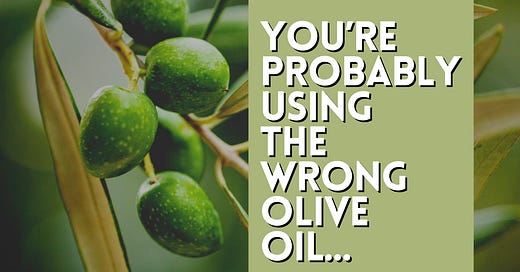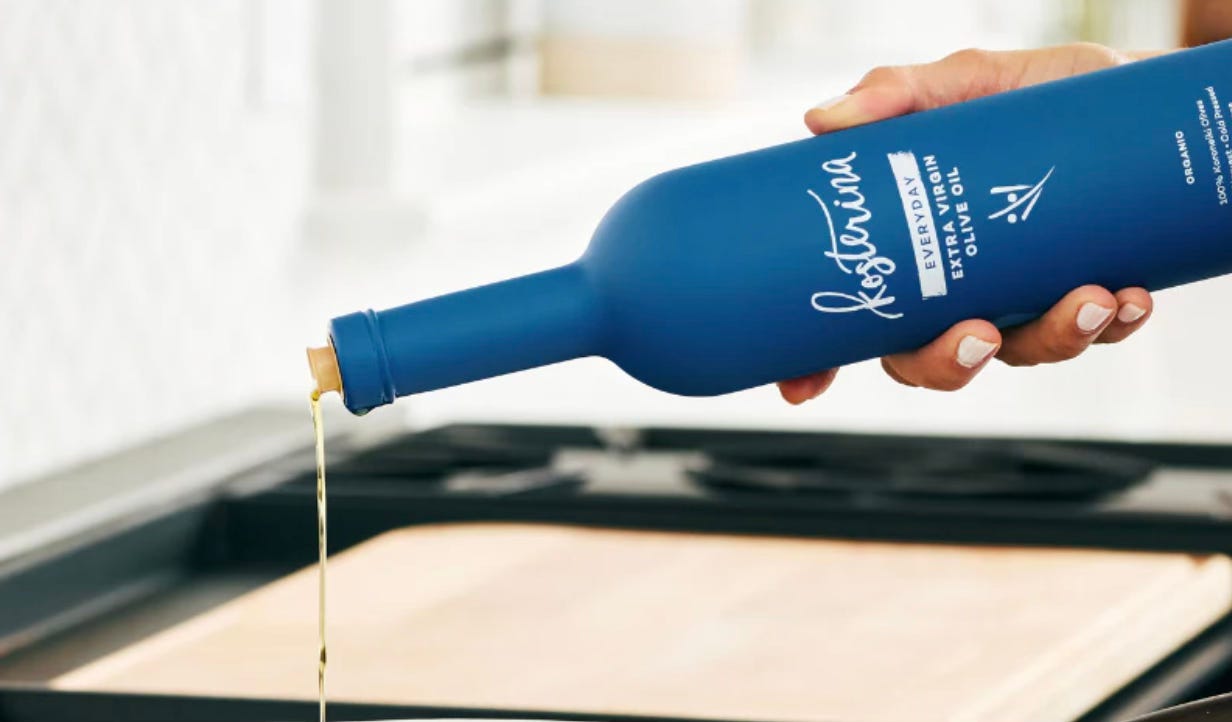You're Probably Using The Wrong Olive Oil...
Let's talk about Smoke Point, Plastics and How To Choose The Right Olive Oil
Did you know that that bottle of organic olive oil sitting in your kitchen might be a blend of olive oils from 4 different countries… and not in a good way? Did you know that choosing organic isn’t enough? Did you know that the container matters? Did you also know that olive oil can be cut with seed oils? Phew… I know that was a lot of questions but let’s dive into some important information about olive oil, what you should look for and what you want to avoid!
In our home, we mainly use olive oil, it’s our favorite oil and also could be because I’m Greek but we use it for all baked goods from banana bread to cake, cookies to muffins… it’s our go-to choice. I do also like avocado oil as well but more often than not I reach for extra virgin olive oil. There’s been a lot of discussion on whether or not olive oil is safe to cook with due to the smoke point but a study from 2018 is says…
In 2018, Acta Scientific Nutritional Health wrote an article called, “Evaluation of Chemical and Physical Changes in Different Commercial Oils during Heating” where they looked at how different cooking oils react when heated with a focus on whether or not the smoke point (the temperature in which oil starts to smoke) indicates how safe and stable the oil actually is. They heated various oils including extra virgin olive oil or EVOO as the cool kids call it and they looked at their chemical properties.
The main findings:
EVOO vs. Other Oils: EVOO produced fewer harmful by-products compared to oils like canola oil.
Fatty Acids and Antioxidants: EVOO stayed stable when heated due to its specific fatty acid makeup and antioxidants. Oils with more poly-unsaturated fats (PUFAs) broke down faster.
Smoke Point: The smoke point wasn't a good indicator of oil performance when heated. Other factors, like oxidative stability and certain chemical measurements, were better predictors.
Basically, EVOO was the best in staying safe and had the most stability under heat and the smoke point wasn’t a reliable measure of an oil’s performance. People often say that oils like canola and cottonseed or soy bean oil are better because they have high smoke points but they are seed oils which you should avoid at all costs! You can learn more about WHY seed oils are a bad option, here.
So all this to say… you’re good to go with olive oil BUT even so you still must choose a good quality olive oil — QUALITY MATTERS!
I’ve talked about how I avoid seed oils at restaurants in this article check it out. Can you really avoid seed oils when eating outside of your home? Yes and no… find out more here.
I used olive oil for everything including baked goods or making my son pancakes and for a long time I was using Costco’s organic olive oil because 1) it was a good price and 2) it was organic and I could buy it in bulk which was handy for recipes and recipe development etc. I have always known that it’s not the best tasting olive oil though as I’ve tried many wonderful olive oils over the years but for convenience and price it’s just what we used. I know a lot of people who use it as well but there are a few things you really need to look for when choosing an olive oil.
Choose an olive oil that is in a glass bottle and avoid plastic always! Plastic leaches into your foods and even your olive oil. When using plastic containers, cups, blenders etc. it’s important to avoid heat, anything acidic or with high fat content. Buying olive oil is no exception to this rule so choosing a glass bottle (or tin can) is very, very important.
Make sure the glass bottle is dark! When olive oil is exposed to light it can oxidize and even deteriorate the olive oil’s benefits and nutrients.
Make sure the olive oil is single origin this way you can trace it back to a specific location and farm. You should also make sure it’s single source and not a blend from multiple countries… Some olive oils are cut down or blended with canola oil or seed oils and others are simple blends of olive oils from different countries which source fancy but in fact it can mean that it’s made with rancid olives or oils or even processed with seed oils. And there’s no traceability. Blends can also be made of low quality, leftover olives. Check the back of the bottle to see the origin of your olive oil.
You should be consuming your olive oil within 2-3 months for maximum benefits and so it doesn’t go bad. Olive oil doesnt age like wine… it can degrade over time. Lastly, if you’re concerned that your olive oil might be cut with seed oils, put 2-3 tablespoons in a glass jar and close the lid. Put the jar in the fridge overnight and if it solidifies then it’s olive oil. If it doesn’t then it has been cut with seed oils of some kind.
I’ve been wanting to write about olive oil for awhile but other topics or recipes have come up and bumped it down the list. About a month ago, an olive oil company reached out to me to send me some of their olive oil to try after I tried and loved a product that they did a collaboration with (Wedding Cake Coconut Yogurt from The Coconut Cult - this flavor was a limited flavor but they have amazing flavors on their site all the time) I loved the olive oil that They sent me and it’s been all that I’ve used since then and I finally put my olive oil blog at the top of the list. Kosterina makes a single origin olive oil from Koroneiki olives in Southern Greece and all their famers use organic farming practices, too. They harvest the olives when they are unripe so that the olives are jam packed with bold flavors and are cold pressed the same day that they are picked. This olive oil is bursting with flavor and contains amazing polyphenols.
Polyphenols in olive oil provide significant health benefits and contribute to the flavor. They contain antioxidants which can reduce oxidative stress, lower the risk of chronic diseases, and improve heart health. Key polyphenols include oleuropein, hydroxytyrosol, and tyrosol, which also give extra virgin olive oil its robust flavor. Preserving the polyphenols in your olive oil is important — so make sure you choose a dark glass bottle (or tin), keep it in a cool place and away from direct light but you knew that already from reading this blog, right?
I’m so stoked that I was able to get a discount code (KRYSTENSKITCHEN) to share with you if you want to try Kosterina olive oil. So far, i’ve been loving their blue bottle (organic) and their white bottle. I recently tried their Blueberry Crushed Fruit Vinegar, too and it tastes more like a blueberries than a blueberry somehow. It’s great for salads of course but I put a splash of it into some sparkling water and it was a home run! They have a skincare line and even olives, too. I highly recommend this amazing olive oil from Kosterina and hope you love it, too. You can use code KRYSTENSKITCHEN on your first order from Kosterina.com
Thank you for subscribing to my substack and a special thank you to my paid subscribers as well. Please consider sharing this article or any of my other posts. Follow me on instagram and check out KrystensKitchen.com for amazing recipes. I also have two cookbooks available here.







